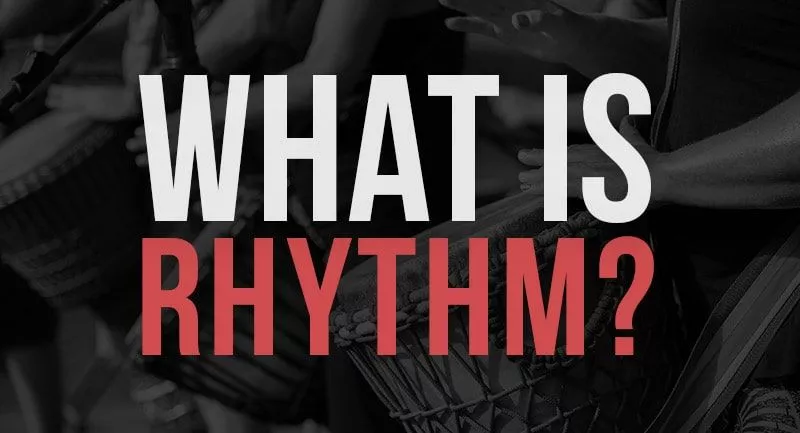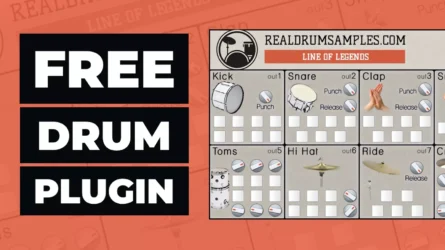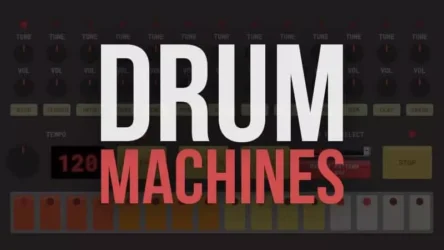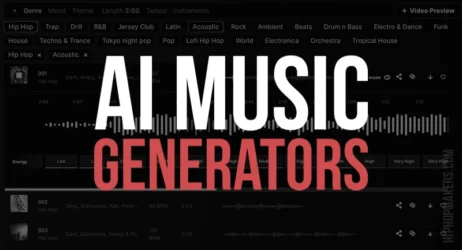This guide will explain what a rhythm in music is, provide rhythm examples, and explain the different types of rhythms in music. So what is rhythm in music?
What Is Rhythm In Music?
The rhythm in music is a pattern of regular and irregular pulses. That when a series of notes and rests repeat in a piece of music, it forms the rhythmic pattern. So the sequence of sounds and silences make the rhythm in a piece of music.
- What is Rhythm in Music
- Examples of Rhythmic Patterns
- Why is Rhythm in Music Important
- How Do Find the Rhythm of a Song
- How Can I Learn Rhythm
- Beat vs Rhythm
What is Rhythm in Music?
In simple words, you can describe rhythm as a regular repeated pattern of movement or sound in a piece of music.
You can think of rhythm in music as the placement of sound in time. According to Britannica, the word Rhythm is derived from The Greek word rhythmos, which means “to flow”.
Melody, harmony, and rhythm are three core components of music. It is important to note that rhythm can exist without melody, but a melody can’t exist without rhythm, and the melody and rhythm together make a piece of impactful music.

Rhythm is the most basic element of a musical form.
When to play the notes, for how long, and with what degree of emphasis all these can be understood from the song’s rhythmic structure.
Unless you have written music that is one single, sustained note without any variations in pitch, you would almost always require rhythm for writing a piece of music. Many times it’s the rhythm that differentiates one form of music from another.
Rhythm is about counting, so you can listen to your favorite pop songs and just feel the beat! You’ll very likely notice that the beats fall into groups such as one, two, three, four; one, two, three, four, etc.
Rhythm drives the music forward. To learn about the rhythm it is important to know about the note values as well:
| Whole Note | One single note that covers a full four-beat measure |
| Half Note | One single note that covers half of a four-beat measure |
| Quarter Note | One single note that covers one-quarter of a four-beat measure |
| Eighth Note | One single note that covers one-eighth of a four-beat measure |
| Sixteenth Note | One single note that covers one-sixteenth of a four-beat measure |
Note that the actual rhythm you hear when you listen to a song is called the surface rhythm.
So when someone says that they like the beat of a pop song, they mean that they enjoy the surface rhythm, which can be simply a rhythmic pattern of the drums.
Piano, guitar, bass, drums, and other instruments can all be considered as rhythm instruments depending on the context they are used for.
In a music group, every musician is responsible for carrying out their rhythmic performances. They are supposed to play the beats and rhythmic patterns with the guidance of the composer of the music piece.
What Are Examples of Rhythmic Patterns in Music?
Here are some of the common rhythmic patterns that you would encounter in a piece of music.
- 3/4: This pattern signifies that there should be three beats in each measure. So the pulse of this music would be 1-2-3, 1-2-3, 1-2-3, and like that. So, if you hear a music piece with the 3/4 time signature, you’ll be able to notice that rhythmic pattern. Waltz is an example of music that uses the 3/4 rhythmic pattern.
- 4/4: It signifies that there will be four beats in each measure. Its pulse counting will be like 1-2-3-4, 1-2-3-4, 1-2-3-4, and so on. You can notice this rhythmic pattern in a march.
- 6/8: As you might have already guessed, it signifies that each measure will have six beats. But here, you should note that the beats get divided into groups of three. So the pattern would look like this: 1-2-3 | 4-5-6, 1-2-3 | 4-5-6, 1-2-3 | 4-5-6, and so on.
Remember that these are just a few common types of rhythmic elements. There can be many more rhythmic patterns.
Why is Rhythm in Music Important?
Rhythm moves through the music as a generative force in several different ways and gives the composition structure.
It helps create the basic pulse of a song, and it helps create the feeling of familiarity and expectation for the listener.
Rhythm is a very important part of music that you can’t think of playing with anyone without it. Just think of an orchestra with many musicians, and none of them have any rhythm. Then obviously, no one will like to hear their music.
How Do You Know the Rhythm of a Song?
Rhythm is part of the song for which you tap your toes, nod your head, and move your feet.
To know the Rhythm of a song, it is important to have some understanding of reading music and music theory.
Whenever a piece of sheet music begins, you can notice the numbers that look like fractions. They are the time signatures that let you know how to divide the beats between each bar line.
In a musical time signature, the top number tells you how many beats are in a single measure. The bottom number provides information on what type of notes those beats are.
For example, in a 4/4 time signature, there are four beats in a measure, and the type of note those beats belong to is the quarter note.
So the rhythmic pattern will be like this: 1-2-3-4, rest, 1-2-3-4, 1-2-3-4.
How Can I Learn Musical Rhythm?
The simple way to learn the basics of rhythm is through tapping and counting the beats. You can use your foot to tap a steady beat and sing different note durations against the beat.
For example, you can start with the basic four-beat rhythm, for which you can tap four beats over and over with your foot and make the beat of 1 the hardest:1-2-3-4,1-2-3-4, 1-2-3-4.
You have to practice similar kinds of exercises which will help you to understand the sense of rhythm.
What is the Difference Between a Beat & Rhythm?
| Beat | Rhythm |
| A beat is the underlying pulsation of music. | A rhythm is a pattern of regular or irregular pulses of music |
| Usually, a beat remains constant in a piece of music. | Usually, a rhythm can be variable in a piece of a music |
| A beat is the unchanging tempo of the piece of music | A rhythm is a pattern in which the notes of the piece move |
Summary of Rhythm
The rhythm in music is a regular or irregular pattern of pulses. Repeated notes and rests form the rhythmic pattern of a piece of music, and rhythm is formed by the sequence of sounds and silences in a piece of music.
Rhythm in music is an integral part of music theory, forming the foundation of all melodies. The musical rhythm involves the arrangement of strong and weak beats, creating a unique rhythmic pattern that varies across different genres and eras of music. Just like sentences in a language, this pattern can be viewed as a small musical sentence, an interconnected series of musical notes that tell a story.
Rhythm refers to the time aspect of music, which is often characterized by time signatures and the underlying pulse. Time signatures, such as duple meter and triple meter, help determine the number of beats in a measure, such as the presence of a strong beat on the first beat and weaker beats on the other beats.
An odd time signature, for instance, can result in interesting rhythms, much like syncopated rhythms, which disrupt the traditional strong-weak pattern by emphasizing off beats.
This contributes to the rich complexity found in contemporary music, from dance music with its steady quarter notes and eighth notes to classical music with its harmonic beats and syncopated rhythms.
In rhythm theory, beats are generally counted as “one and,” especially in Western music, where the quarter note typically gets the beat. This could change in complex rhythms where a half note or eighth note might take the spotlight. For example, in a musical meter known as ‘triple time,’ the first beat is strong, followed by two weak beats. This pattern is often expressed in quarter notes or three-eighth notes, making the same rhythm feel different.
Many musical features are dictated by rhythm, such as tempo. A slow tempo, like a leisurely walking pace, would mean the beats form more slowly, allowing the longest playing duration for each musical note.
In contrast, upbeat popular music often features a quicker tempo with more beats per minute. Instruments perform rhythms at these varied tempos, further demonstrating the beauty and diversity of musical rhythm.
For beginners, understanding the difference between a strong beat and a weak beat, or learning to read sheet music, may initially be challenging. However, it’s a crucial part of the creative process in music.
Understanding how a musical note represents a strong or weak melodic element is key, whether it’s the emphasis of a syncopated beat or the subtlety of an unaccented beat. Remember, the second eighth note in a measure is usually a weak beat, adding to the dance of strong and traditional weak beats that shape our musical experiences.
In conclusion, rhythm, from simple and compound time to odd time signatures and beyond, plays an essential role in how we perceive and appreciate music.
Whether it’s a syncopated rhythm in contemporary music or the use of a fourth beat in classical pieces, the rhythm keeps our toes tapping, our hearts pounding, and our spirits dancing, making music a universal language that speaks to all of us.
I hope you found this information on rhythm in music helpful.




